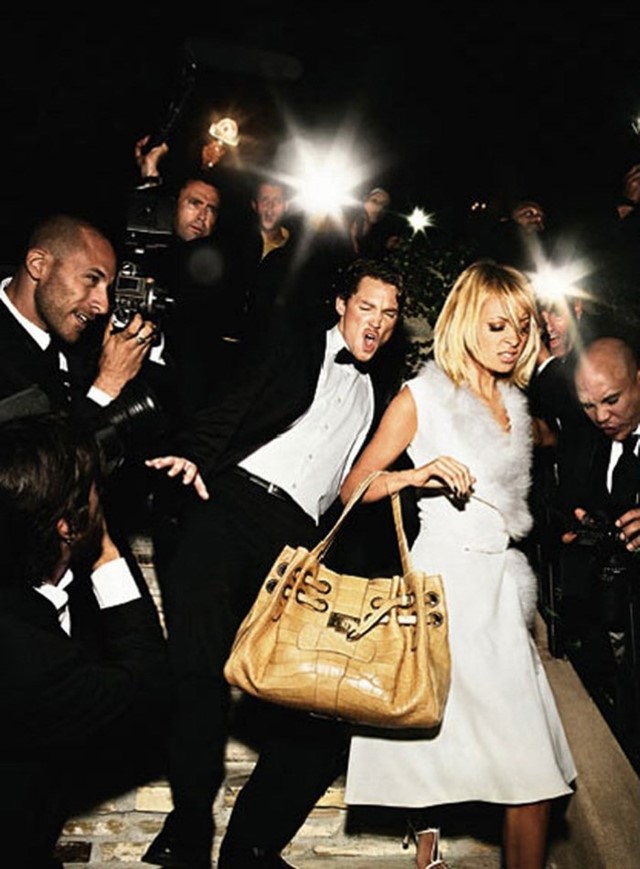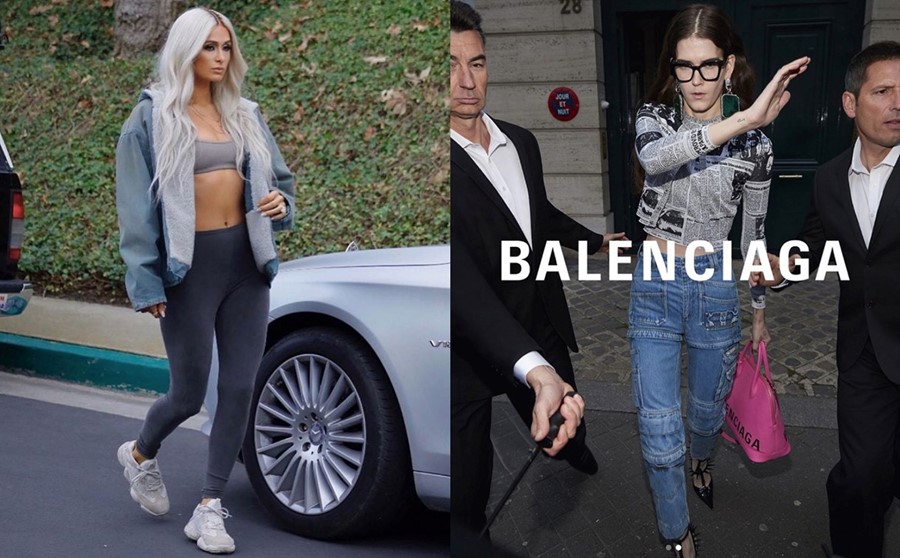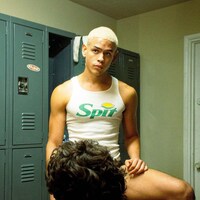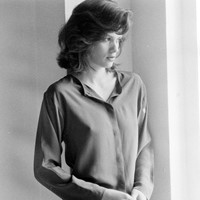First Yeezy, now Balenciaga – but fashion’s tangled relationship with the paps goes back a long time
Within 24 hours of one another, two new season visuals hit our phone screens – first from Kanye West’s line Yeezy, then from Balenciaga. Both reappraise the role of paparazzi in fashion, paying side-eyed tribute to the seedy power that has made its mark on the way we see the world. At first glance, it’s unexpected that a storied fashion house like Balenciaga might use paparazzi-style photos, associated with the most invasive and dangerous aspects of fame and celebrity, and totally at odds with the exclusive and hidden codes of luxury. Similarly, it’s an inventive move for a brand like Yeezy, which must work to overcome the industry stigma of having a celebrity designer in order to be accepted as a luxury design heavyweight. The paparazzi language the Yeezy shots show is one you might think West would have to leave behind in order to gain a seat at the high fashion table.
The paparazzi have been situated in a curious position somewhere between the low and the highbrow since the concept came into existence. The term paparazzi itself comes from a character from Italian master director Federico Fellini’s 1965 cinema classic film La Dolce Vita, named Paparazzo. The character was a photographer based on Tazio Secchiaroli, who was said to be Italy’s first paparazzo after he snapped pictures of the film’s lead actress, Anita Ekberg, enjoying a night out in Rome with her husband some years prior. His assertive tactics when trying to get a shot were mined by Fellini over a number of frank conversations. Fellini said in a Time magazine interview that “Paparazzo ... suggests to me a buzzing insect, hovering, darting, stinging,” giving us an indication of the paparazzi’s reputation: irritating, hard to avoid but near invisible, sinister, dangerous – an image the photographers have found hard to shake, as they are still often described as swarming.
Before Instagram, their photos allowed us a glimpse at the lives of the rich and famous, jumping the turnstiles of money and social connections that would allow us into the same room as our celebrity idols. However, the paparazzi transaction – the photos being taken, our consumption of them – is tinged with dishonesty and exploitation, considering they are often captured unwillingly. In the few swift years when paparazzi portraiture was first beginning, tropes of the genre began to emerge, clearly displaying the infringements of privacy that such a shot entails: blocking the lens with a hand, and covering the face with sunglasses, an arm, or whatever prop the celebrity subject in question has to hand. The paparazzi as a group and concept were undoubtedly perceived negatively, and never more reviled than in the wake of Princess Diana’s death – the behaviour of the pursuing photographers was said to have contributed to the cause of the crash, and upon arriving at the scene, they were said to have started snapping rather than attending to the injured parties.
Over time, though, the negative patina of paparazzi has faded somewhat. They have become part of the landscape, accepted if not exactly venerated. While celebrities and their PRs fear intrusive lenses in their direction at the wrong moment, they came to be seduced by, or at least afford a grudging respect to, the paps’ star-making quality. Celebrities know the power of being seen in the right place could boost their social stock, but a bad image could cause lasting career damage. Paparazzi gained a position as the mistress to celebrity: courted and entertained (even phoned by publicists to alert them to a celebrity’s whereabouts) but never publicly accepted. Andy Warhol details his and his cohorts’ emotional tango with the paparazzi in his diaries, talking teasingly of Bianca Jagger planning to get her photo taken at various events, but on the other hand, worrying to himself that he is no longer important when he is not papped.
The explosion in popularity of celebrity gossip, fuelled by the twin powers of reality TV and the internet, became the vector for paparazzi photography and its aesthetic to become accepted parts of visual culture. Diana’s tragic death in 1997 did not curb the paparazzi’s dangerous behaviour, and instead the 2000s ushered in a platinum age for paparazzi photography. Reality TV dominated TV schedules and gossip columns, with comedy and soap opera formats like The Simple Life and The Hills gaining positions as cultural bellwethers. Coupled with the internet’s newfound presence in daily life – case in point: online gossip megalith TMZ was founded in 2005 – paparazzi became kingmakers. The right image of a celebrity outfit could spark a fashion trend, photographers could be set for life with just a few key shots of Britney Spears in crisis, and equally, ambitious wannabe stars could wangle themselves exposure, endorsement deals and screen time. Kim Kardashian West is one of the canniest operators in this arena, appearing side-by-side with friend Paris Hilton, before following in the heiress’s footsteps to leverage her sex tape scandal into the hugely popular Keeping Up With The Kardashians series which has made her and her family some of the richest and most famous women in the US.
“Andy Warhol details his emotional tango with the paparazzi in his diaries, talking teasingly of Bianca Jagger planning to get her photo taken at various events, but worrying to himself that he is no longer important when he is not papped”
In fact, the visual landscape of the 00s was defined by paparazzi photos, whether in gossip magazines like People and Hello! or on screen via blogger Perez Hilton (who himself would become a celebrity). Any casual media consumer can recognise the visual characteristics: dynamic on-the-go shots, camera flashes over-lighting faces, quotidian urban environments, luxury vehicles (particularly SUVs or limousines). The subjects were typically white, blonde, rich, and extremely thin, and at least to start with, caught in a state of disrepair: stumbling into or out of cars (often sans underwear) and clubs, grabbing Frappuccinos in velour sweats and Ugg boots, baseball cap and sunglasses failing to hide their acne or smudged make-up. The era of the ‘hoop of shame’, where any perceived body flaw (cellulite, fat roll, fake tan line) was highlighted by a stark coloured ring, inculcated a need to look flawless at all times; something in which Kim Kardashian West, star of the Yeezy campaign, specialises.

The tension between fame and privacy, controlled images and candid ones, saw paparazzi photography invade the exclusive echelons of high fashion, extending into the industry through editorials. In Vogue Italia, photographers Tim Walker and Steven Meisel both commented on the swelling power of the photographer packs by reproducing their hallmarks – the voyeurish angles, the casual poses, the hand blocking the view of the face – in 1999 and 2005, respectively. Meanwhile, the now-ousted Mario Testino and Terry Richardson both shot similar series for Vogue Paris in 2008 and 2013. A generation of young readers saw the visual signature of the tabloid magazines and gossip sites replicated even in the rarified air of glossy magazines, the hallmarks of the paparazzi elevated from Fellini’s swarming mosquitoes into the realm of art. The paparazzi aesthetic could be aped, and it had been, on the highest of stages.
Being chased by the paparazzi had thus had its position as a social status marker consolidated – which led to a spate of paparazzi-themed fashion campaigns, the pinnacle of which was Nicole Richie – daughter of Lionel, ex-best friend of socialite Paris Hilton and reality TV star from the Simple Life – pictured looking somehow simultaneously celestial and harried by paps in a Jimmy Choo campaign (Jimmy Choo being the contemporary hallmark of the mid 2000s of the conspicuous consumption of luxury goods). Lady Gaga’s 2008 hit Paparazzi shored up the tragic yet desirable nature of paparazzi attention “I’m so loved, it’s killing me” – an ironic critique of the desperation for fame as the pop provocateur was, at the same time, courting paps’ attention through headline-grabbing outfits including her infamous meat dress.
During Raf Simons’ tenure as creative director at Dior, the house launched a 2012 Miss Dior handbag campaign starring the actress Mila Kunis as ‘the kind of woman accustomed to attention from throngs of paparazzi‘, in the words of WWD. Being hounded by photographers therefore appears as a thrilling game to which consumers might aspire, a reflection of feminine allure. Perfume campaigns presented paparazzi attention uncritically as a visual by-word for adoration – a kind of luxury good that you can achieve, if you are special enough. 2012 saw music producer Mark Ronson appeared in the backseat of a taxi, with elite model Anja Rubik nestled into his neck, surrounded by camera flashes in the Fan di Fendi pour Homme campaign.
The paparazzi scrum, most commonly found at the departure lounge at LAX, further became implicated in the fashion industry through the phenomenon of street style. The appetite for candid photos of real people (fashion editors) meant that enterprising photographers made their careers snapping outside the shows. The tension between street style stars and editors simmered, editors complaining of the photographers’ aggression and the bloggers’ “peacocking” (not to mention what seemed to be an uncomfortable shift of power towards those with thousands of followers). The media landscape became once again saturated with paparazzi-esque shots, still of fast walking women, often on phones or clutching show invitations, but now clad in premium brands, rather than incognito jeans and baseball cap or sloppy sweats. If you’ve been to fashion week, the sight of someone repeatedly imitating candid behaviours (“hailing” a cab, strolling down the street only to turn and do it again) for a crowd of photographers is a familiar one.
As fashion switched its attention to social media, Instagram destabilised the paparazzi’s primacy by allowing celebrities themselves to create their own content and self-publish their ‘real’ lives. This is key to understanding the return to paparazzi tropes in fashion imagery. While Moschino’s SS17 campaign, featuring the much-photographed Hadid sisters, feels more in line with the images of Richie, these new campaigns portray a deeper sense of self-awareness about the nature of fashion, exposure, and self-presentation today. Balenciaga’s creative director Demna Gvasalia has mined fashion’s purported antitheses – dad dressing, ill-fitting clothes, Crocs – and repositioned them as desirable. Likewise, paparazzi is tacky, associated with the lurid gossip mags and ‘untalented’ reality TV stars, and thus subversive: a perfect cultural phenomenon for him to explore fashion through. There’s also the tint of nostalgia he’s employed in his designs – remember the Juicy Couture / Vetements collab? The prominently-placed Balenciaga handbags are also a throwback to the it-bag days of yore, where a product’s placement on a celebutante’s arm could send desire for it skyrocketing.
Likewise, Kanye West knows the power of paparazzi more than most. His choice to publicise the new season collection through staged paparazzi shots of Kardashian West and other celebrity models is in itself a reproduction of the paparazzi’s own work that has made him and his wife rich and powerful. Kim and her lookalikes wear the typical outfits known from the 00s TMZ canon – in baseball caps, vest top and sweatpants, and the photos themselves are situated in the typical urban scenarios: clutching car keys by an SUV, walking out of a convenience store. Likewise, Kardashian West’s lookalikes reflect the decoy cars and body doubles used by celebrities to divert paparazzi attention, and the models themselves include paparazzi targets, including Paris Hilton (who Kim was regularly snapped with back in the day) and Sarah Snyder, ex of Jaden Smith who even had her own internet-famous mugshot.
“As fashion switched its attention to social media, Instagram destabilised the paparazzi’s primacy by allowing celebrities themselves to create their own content and self-publish their ‘real’ lives”
Balenciaga chooses to return to the mid-00s, in doing so highlighting the construction and artifice of fashion trends just as paparazzi photos profit from highlighting the artificial nature of fame. The decision not to use a name from the pool of established fashion photographers undoubtedly available to them and instead, recruit actual French paparazzi for a French newswire for the shoot is the cherry on top. Yeezy recreates the images to which Kanye and Kim’s fortune can be accredited, rendering the originals meaningless – if the celebrities produce the paparazzi photos themselves, what is the point of the paparazzi? The Kardashian Wests have not only bitten the hand that feeds but have also proved they can feed themselves just fine, thanks. Ultimately, both sets of images explore the idea of exposure and influence, but most importantly fashion’s shifting balance of power. In a world where Rihanna can drop a make-up line that throws the entire beauty industry into disarray, brands and celebrities alike can independently turn their content into internet-breaking opportunities – and they don’t need a gossip magazine for it to go viral.




